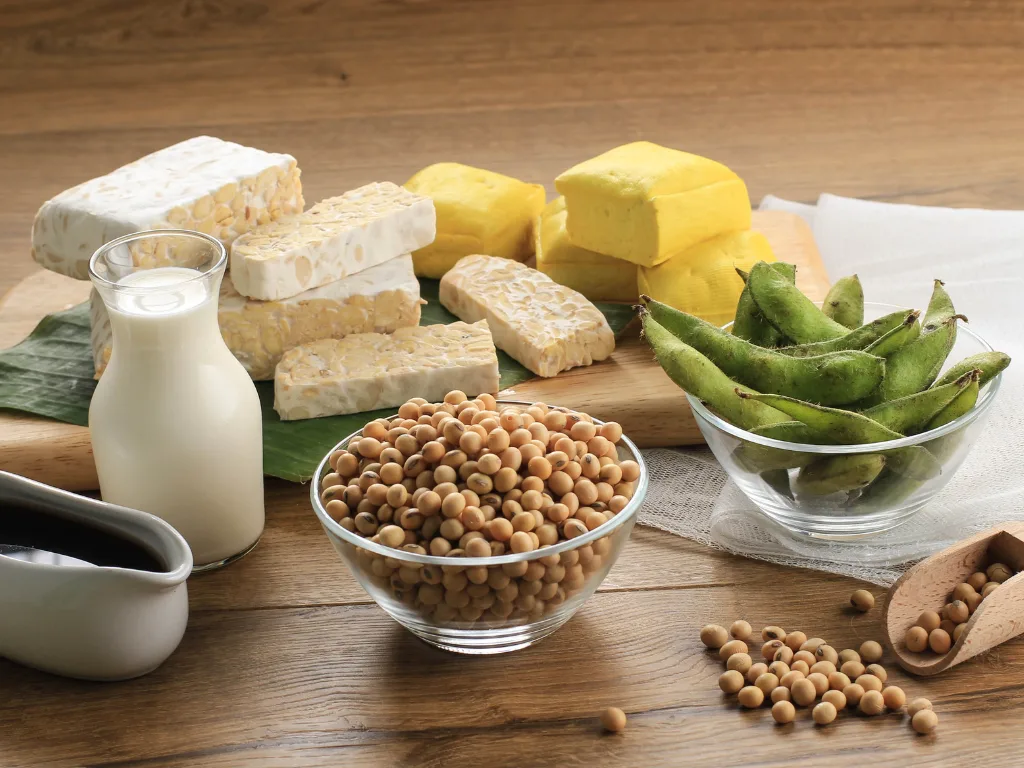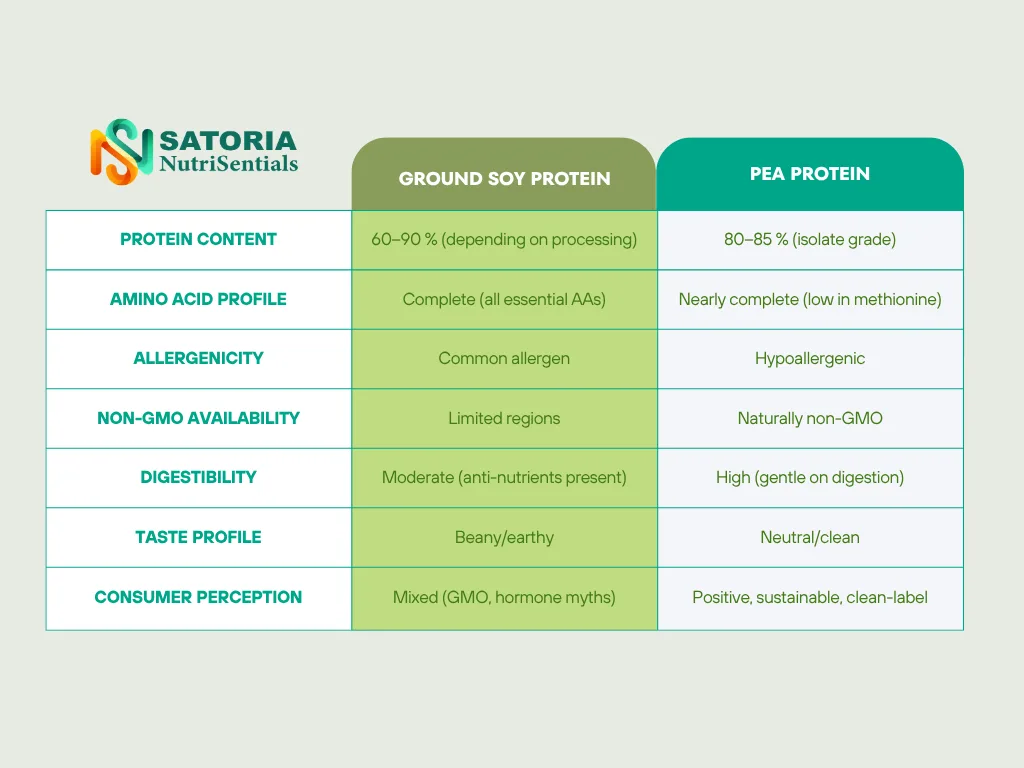Ground Soy Protein vs Pea Protein: Why the Future of Plant-Based Innovation Belongs to Pea
November 26, 2025

Plant-based proteins have become the backbone of today’s food innovation. From beverages and bakery to nutrition bars and dairy alternatives, manufacturers are under pressure to deliver high-protein, clean-label, and sustainable products that consumers can trust.
For years, ground soy protein dominated this category. Yet the industry is shifting—and fast. As demand evolves toward allergen-friendly, non-GMO, and transparent ingredient sourcing, pea protein is taking the lead.
For ingredient partners like Satoria Nutrisentials, which specialize in functional, clean-label solutions for B2B manufacturers, understanding this transition is key. Pea protein offers everything soy promised—and more—without the drawbacks that now hold soy back in the eyes of formulators and consumers alike.
The Rise (and Plateau) of Ground Soy Protein
Soy protein earned its reputation early as one of the first widely adopted plant-based proteins. Its high protein content, complete amino acid profile, and reliable supply made it the go-to option for decades.
Manufacturers embraced ground soy protein because it could easily be added to bakery, cereals, beverages, and even plant-based meats.
However, times have changed. The same factors that once made soy attractive are now prompting manufacturers to look for alternatives:
- Allergen classification — Soy is one of the eight major allergens globally, requiring special labeling and facility segregation.
- Consumer perception — Growing concern around genetically modified soybeans and hormonal effects has damaged soy’s image among health-conscious buyers.
- Supply volatility — Soy’s heavy dependence on global commodity markets exposes manufacturers to price swings and origin uncertainty.
- Flavor challenges — Despite technological improvements, soy’s “beany” aftertaste remains a sensory challenge in delicate applications like beverages.
While soy protein continues to play a role in certain legacy products, manufacturers aiming for premium or clean-label positioning increasingly find themselves exploring other options—especially pea protein.
Why Pea Protein Is Surpassing Ground Soy Protein
Allergen-Friendly and Non-GMO by Nature
Unlike soy, pea protein is naturally non-allergenic and non-GMO. This alone eliminates a major regulatory and operational burden for manufacturers targeting the “free-from” market.
Products that carry allergen-friendly claims—“soy-free,” “dairy-free,” “gluten-free”—have seen consistent double-digit growth across multiple markets. By using pea protein instead of soy, brands can meet these consumer expectations without costly production segregation or labeling constraints.
Cleaner Label, Cleaner Image
Clean-label demand has evolved beyond ingredient lists—it now includes sourcing transparency and environmental trust. Soy farming, associated in some regions with deforestation, faces scrutiny from sustainability-conscious buyers.
Pea protein, derived from yellow split peas, offers a naturally clean, sustainable alternative. It requires less water and fertilizer, fixes nitrogen back into the soil, and supports crop rotation systems that reduce environmental impact.
For manufacturers promoting eco-friendly or sustainable narratives, this is a clear win.
Neutral Taste and Versatility
Taste remains the deciding factor in consumer acceptance. Compared to ground soy protein, pea protein has a milder, more neutral flavor profile that blends seamlessly in a variety of applications—from ready-to-drink beverages to baked goods.
Its clean sensory profile allows formulators to reduce the need for masking agents or artificial flavors, resulting in simpler formulations and lower costs.
Digestibility and Consumer Comfort
Soy protein is nutritious, but it can cause digestive discomfort for some individuals due to oligosaccharides and anti-nutritional factors.
Pea protein, in contrast, is gentle on digestion and hypoallergenic, making it ideal for sensitive consumers or functional nutrition products that require high tolerance and absorption efficiency.
Functional Performance That Meets Industrial Demands
Modern pea protein isolates—like those developed and supplied by Satoria Nutrisentials—match or surpass soy in key functional properties:
- Excellent solubility and dispersion in liquid systems.
- Strong emulsification and water-binding capacity for bakery and meat analogues.
- Stable foaming and gelation properties for confectionery and desserts.
- High thermal stability, suitable for extrusion and spray drying.
The result is a plant-based ingredient that performs reliably across product categories, without the formulation headaches often associated with soy.
Comparing Nutritional Profiles: Soy vs Pea

The nutritional gap between the two is minimal, but the market perception and operational advantages of pea protein make it the future-ready choice for forward-looking manufacturers.
The Business Case: Why F&B Manufacturers Are Switching
The shift from soy to pea protein isn’t just about health or sustainability—it’s a strategic business decision.
Here are the main reasons leading manufacturers are making the switch:
- Broader consumer reach — Pea protein enables entry into allergen-sensitive, vegan, and flexitarian markets.
- Premium brand positioning — “Soy-free” and “non-GMO” front-of-pack claims enhance trust and perceived value.
- Streamlined operations — Reduced allergen handling means fewer production constraints and lower QA costs.
- Supply chain stability — Pea protein production is expanding globally, offering secure sourcing independent of commodity soybean fluctuations.
- Better taste and texture — Easier flavor masking and smoother mouthfeel mean faster R&D turnaround and higher consumer satisfaction.
For B2B partners of Satoria Nutrisentials, this translates to reduced formulation risk, faster time-to-market, and stronger product differentiation.
Applications Where Pea Protein Outperforms Ground Soy Protein
Beverages and RTD Nutrition Drinks
Soy beverages once dominated plant-based dairy alternatives, but pea protein is rapidly taking over. Its neutral taste, high solubility, and stability make it ideal for ready-to-drink products, protein waters, and shakes.
Formulators can achieve desired viscosity and clarity without the sedimentation issues often caused by ground soy protein.
Bakery, Confectionery, and Protein Snacks
Pea protein enhances texture, moisture retention, and protein content without overpowering the flavor profile.
Its natural color and dispersibility make it ideal for bars, cookies, and snack bites—particularly for brands emphasizing “plant-based indulgence.”
Plant-Based Meats and Seafood
Textured pea protein replicates the fibrous, meat-like bite consumers expect in next-generation plant-based meats.
Unlike soy, it avoids allergen warnings while delivering similar emulsification and fat-binding properties for juicy, realistic textures.
Dairy Alternatives and Functional Foods
In dairy-free yogurts, ice creams, or nutrition blends, pea protein provides structure, smoothness, and a clean sensory base.
Its compatibility with other plant proteins or fibers allows for balanced nutrient delivery—perfect for brands creating high-protein functional foods.
Pea Protein and the Future of Clean-Label Manufacturing
The clean-label trend isn’t just a consumer movement—it’s shaping procurement, R&D, and marketing strategies across the B2B supply chain.
Pea protein embodies everything the next generation of clean-label ingredients stands for:
- Short, recognizable ingredient name
- No allergens or additives
- Sustainable agricultural source
- Traceable origin and compliance with global standards
- Functional consistency across processing methods
As global regulations tighten on labeling, and consumer expectations for ethical sourcing rise, manufacturers using soy will find it harder to maintain “clean-label” credibility.
Pea protein, in contrast, aligns effortlessly with transparency and sustainability-driven business models.
Why Satoria Nutrisentials Is the Ideal Partner for Pea Protein Solutions
Satoria Nutrisentials specializes in supplying science-backed, functional ingredients designed for industrial performance and consumer trust.
Our pea protein range is developed for versatile use across F&B applications—engineered to offer clean flavor, excellent solubility, and consistent texture.
What Sets Satoria Apart
- Trusted manufacturing standards — ISO, HACCP, and Halal-certified production.
- High functionality — Optimized solubility and dispersion for beverage systems.
- Sustainability commitment — Responsibly sourced ingredients with traceable supply chains.
- Technical expertise — R&D support for custom formulations, blends, and product testing.
Satoria’s pea protein portfolio provides manufacturers with a dependable base for product innovation—whether for dairy-alternative beverages, bakery, nutrition bars, or high-protein snacks.
Custom Blends and Formulation Support
Our technical team partners with clients to develop bespoke blends that combine pea protein with other functional ingredients—like resistant dextrin for fiber enrichment or rice protein for amino acid balancing.
This holistic, solution-oriented approach ensures that every manufacturer achieves optimal performance, taste, and consumer acceptance.
Addressing the Common Misconceptions About Soy vs Pea
- “Soy has higher protein quality.”
Modern pea protein isolates now match soy’s digestibility and amino acid profile, making the nutritional difference negligible. - “Soy is cheaper.”
While raw soybeans may appear cheaper, allergen management, segregation, and GMO compliance often increase total production costs. - “Soy is better for texture.”
Advanced pea protein technology delivers equivalent or superior emulsification and gelation, especially in meat analogues. - “Consumers don’t know pea protein yet.”
Pea protein’s awareness has surged. Major global brands—from sports nutrition to beverages—now promote it as the preferred clean protein source.
The data is clear: pea protein isn’t just an alternative—it’s the new standard.
From Soy to Pea: The Next Chapter of Protein Innovation
The plant-protein industry is undergoing a generational shift. Manufacturers are reevaluating ingredient portfolios to align with future trends—clean labels, allergen-free claims, sustainability, and versatility.
Ground soy protein will continue to play a role in commodity formulations, but the innovation frontier belongs to pea protein.
For food and beverage manufacturers, adopting pea protein is more than a switch—it’s an investment in brand resilience and market relevance.
Take the Next Step with Satoria Nutrisentials
Ready to explore how pea protein can elevate your next product line? Partner with Satoria Nutrisentials, a trusted functional-ingredient manufacturer dedicated to helping you create cleaner, smarter, and more sustainable food solutions.
- Source premium, high-performance pea protein for your formulations.
- Access technical expertise for custom blends and process optimization.
- Gain full traceability, documentation, and global compliance support.
- Bring plant-based innovation to life—from concept to commercial scale.
Let’s shape the future of plant protein—together. Contact Satoria Nutrisentials today to discover how our pea protein can transform your formulations.
References
- Boye, J., Zare, F., & Pletch, A. (2010). Processing of plant-based protein ingredients and their application in food systems. Food Research International, 43(5), 135–144.
- Li, M., & Ma, Y. (2021). Comparative study on functional properties of soy and pea protein isolates. Journal of Food Science and Technology, 58(3), 911–920.
- Mintel Global New Products Database (2023). Trends in plant-based protein claims.
- Satoria Nutrisentials. (n.d.). Products Overview and Company Profile.
- World Plant Protein Association (2022). Market Outlook: Global Plant Protein Demand and Sustainability Trends.